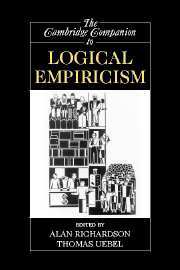Book contents
- Frontmatter
- Introduction
- Part I The Historical Context of Logical Empiricism
- Part II Logical Empiricism: Issues in General Philosophy of Science
- 4 Coordination, Constitution, and Convention: The Evolution of the A Priori in Logical Empiricism
- 5 Confirmation, Probability, and Logical Empiricism
- 6 The Structure of Scientific Theories in Logical Empiricism
- Part III Logical Empiricism and the Philosophy of the Special Sciences
- Part IV Logical Empiricism and its Critics
- Bibliography
- Index
- Series List
6 - The Structure of Scientific Theories in Logical Empiricism
from Part II - Logical Empiricism: Issues in General Philosophy of Science
Published online by Cambridge University Press: 28 January 2008
- Frontmatter
- Introduction
- Part I The Historical Context of Logical Empiricism
- Part II Logical Empiricism: Issues in General Philosophy of Science
- 4 Coordination, Constitution, and Convention: The Evolution of the A Priori in Logical Empiricism
- 5 Confirmation, Probability, and Logical Empiricism
- 6 The Structure of Scientific Theories in Logical Empiricism
- Part III Logical Empiricism and the Philosophy of the Special Sciences
- Part IV Logical Empiricism and its Critics
- Bibliography
- Index
- Series List
Summary
THE THEORY QUESTION
A central question of philosophy of science, arguably the most central one, is “What is the structure of scientific theories?” Some contemporary philosophies of science have challenged the centrality of this “theory question” (henceforth T-question), arguing that it is more important to get an adequate understanding of the practice of scientific inquiry. Yet the logical empiricists placed great emphasis on theory: “Theories . . . are the keys to the scientific understanding of empirical phenomena: to claim that a given kind of phenomenon is scientifically understood is tantamount to saying that science can offer a satisfactory theoretical account of it” (Hempel 2001 (1970), 218). Hence, investigating the structure of these “keys” ought to be a central task for philosophy of science. As has been often observed, the basic problem of logical empiricism was how to be a good empiricist and at the same time “logical.” Or, to cast it in a more historico-philosophical setting, the problem was how the empiricist legacy of philosopher-scientists such as Ernst Mach and Pierre Duhem could be combined with the exigencies of modern logic and mathematics. As will be shown, this problem is intimately related to the problem of answering the T-question in an acceptable empiricist way.
The importance the logical empiricists attributed to the T-question does not mean that they always formulated it explicitly. Often they addressed it by asking questions about the nature of scientific knowledge, or they embedded it in more general problems such as “What is the structure of empirical science?” or “What is the structure of the language of empirical science?”
- Type
- Chapter
- Information
- The Cambridge Companion to Logical Empiricism , pp. 136 - 162Publisher: Cambridge University PressPrint publication year: 2007
- 11
- Cited by



